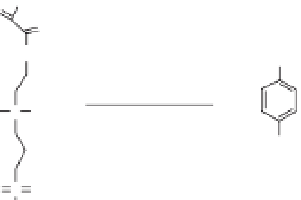Biomedical Engineering Reference
In-Depth Information
CH
3
C
CH
3
CH
3
H
2
C
H
2
C
C
CH
2
O
O
O
O
H
2
C
NH
O
CH
3
20
80
AIBN
+
N
+
O
HN
H
3
C
N
CH
3
CH
3
H
2
O/acetate
H
3
C
(
a
)
+
N
3
O
S
O
N
3
O
S
-
O
-
O
O
CH
3
H
2
C
CH
3
CH
3
CH
3
H
2
C
C
C
H
2
C
CH
2
C
O
5
O
O
O
95
NH
-
AIBN
NH
CH
CH
2
NH
(
b
)
NH
+
-
HC
COO
COO
CH
2
+
+
NH
NH
HN
N
3
N
3
HN
H
2
C
CH
3
C
CH
3
CH
3
C
C
O
C
H
2
C
C
C
CH
2
CH
2
CH
3
C
O
O
95
(
c
)
C
NH
O
5
NH
O
AIBN
Ethanol
+
CH
2
CH
2
O
CH
2
CH
2
N
3
5
N
3
5
OH
OH
Figure 11.10
Synthesis of photoreactive polymers containing (a) sulfobetamine,
(b) carbobetaine, and (c) polyethylene glycol in the side chains. AIBN,
azobisisobutylnitrile.
by static contact angle measurements showing that the polar sulfobetaine
groups were present on the surface. This zwitterionic group sulfobetaine
containing a photoreactive polymer also showed signifi cant reduction in
protein and mammalian cell adhesion onto the photoimmobilized surfaces
compared with the nonimmobilized surfaces.
11.3.1.3 Carbobetaine
A novel photoreactive polymer with histidine polar groups has been syn-
thesized through the copolymerization of two types of methacrylic acid,
one carrying histidine groups and the other carrying azidoaniline groups
[43, 44]. Polar histidine groups containing a photoreactive polymer were
prepared by reacting two of the methacrylates, namely methacryloyl-
L-histidine and 4-azidophenyl methacrylamide carrying histidine and





















Search WWH ::

Custom Search